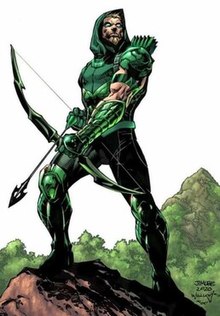
Back السهم الأخضر Arabic Green Arrow AST Yaşıl Ox Azerbaijani Зелената стрела Bulgarian Green Arrow Catalan Green Arrow Czech Green Arrow Danish Green Arrow German Green Arrow Greek Flecha Verde Spanish
| Green Arrow | |
|---|---|
 Textless variant cover of Green Arrow: 80 Years of the Emerald Archer collection (March 2021). Art by Jim Lee. | |
| Publication information | |
| Publisher | DC Comics |
| First appearance | More Fun Comics No. 73 (November 1941) |
| Created by | Mort Weisinger George Papp |
| In-story information | |
| Alter ego | Oliver Jonas "Ollie" Queen |
| Species | Human Spectre (Arrowverse) |
| Place of origin | Star City |
| Team affiliations | Team Arrow Justice League Justice League United Queen Industries Outsiders Seven Soldiers of Victory Justice League Elite Justice League Task Force |
| Partnerships | Dinah Laurel Lance Speedy (various) Connor Hawke Emiko Queen The Flash John Constantine Green Lantern (Hal Jordan) |
| Abilities |
|
Green Arrow is a superhero who appears in American comic books published by DC Comics. Created by Mort Weisinger and designed by George Papp, he first appeared in More Fun Comics No. 73 on September 19, 1941 (cover dated November 1941), the same issue that debuted Aquaman. His real name is Oliver Jonas Queen, a wealthy businessman, owner of Queen Industries, and a well-known celebrity in Star City. He uses this position to hide the fact that he is Green Arrow.[1] Partly inspired by Robin Hood, Green Arrow is an archer who uses his skills to fight crime in his home cities of Star City and Seattle, as well as alongside his fellow superheroes as a member of the Justice League. The world's greatest archer, as well as a competent swordsman and martial artist, Green Arrow deploys a range of trick arrows (in contemporary times, they are referred as "specialty arrows"[2]) with various special functions, such as glue, explosive-tipped, grappling hook, flash grenade, tear gas, and even kryptonite arrows for use in a range of special situations.
Green Arrow enjoyed moderate success in his early years, becoming the cover feature of More Fun, as well as having occasional appearances in other comics. Throughout his first twenty-five years, however, the character never enjoyed greater popularity. In the late 1960s, writer Denny O'Neil, inspired by the character's dramatic visual redesign by Neal Adams, chose to have him lose his fortune, giving him the then-unique role of a streetwise crusader for the working class and the disadvantaged. In 1970, he was paired with a more law and order-oriented hero, Green Lantern, in a ground-breaking, socially conscious comic book series.[3] Since then, he has been popular among comic book fans and most writers have taken an urban, gritty approach to the character. Oliver Queen was killed off in the 1990s and replaced by a new character, Oliver's son Connor Hawke. Connor, however, proved a less popular character, and the original Oliver Queen character was resurrected in the 2001 "Quiver" storyline, by writer Kevin Smith. In the 2000s, the character has been featured in bigger storylines focusing on Green Arrow and Black Canary, such as the DC event The Green Arrow/Black Canary Wedding and the high-profile Justice League: Cry for Justice storyline, prior to the character's relaunch alongside most of DC's properties in 2011.
Green Arrow was not initially a well-known character outside of comic book fandom: He had appeared in a single episode of the animated series Super Friends in 1973. In the 2000s, the character appeared in a number of DC television properties, including the animated series Justice League Unlimited, Young Justice, The Batman and Batman: The Brave and the Bold, and several DC Universe Animated Original Movies. In live action, he appeared in the series Smallville, played by actor Justin Hartley, and became a core cast member. In 2012, the live action series Arrow debuted on The CW, in which the title character was portrayed by Stephen Amell, and launching several spin-off series, becoming the starting point for a shared television franchise called the Arrowverse.
- ^ Greenberger, Robert (2008). "Green Arrow". In Dougall, Alastair (ed.). The DC Comics Encyclopedia. New York: Dorling Kindersley. pp. 142–143. ISBN 978-0-7566-4119-1. OCLC 213309017.
- ^ Brown, Elliot (December 2002). "Green Arrow's Weapons". Green Arrow Secret Files and Origins. 1 (1).
- ^ Green Lantern (vol. 2) No. 76 (April 1970) through 89 (April/May 1972)